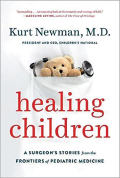BOOKMARK
- Title: Healing Children: A Surgeon’s Stories From the Frontiers of Pediatric Medicine
- Author: Kurt Newman, MD
- Publisher: Penguin Publishing Group
- Publication date: June 2017
- Price: $27.00, hardcover, 272 pages
CARING FOR sick children brings with it a set of emotional and physical challeneges that differ from those with the adult patient population. In a new book, Healing Children: A Surgeon’s Stories From the Frontiers of Pediatric Medicine, Kurt Newman, MD, draws on more than 30 years of his experiences as a nationally regarded pediatric surgeon at Children’s National Health System in Washington, DC, where he serves as President and Chief Executive Officer. This fine book opens an intimate window into the world of pediatric surgery and the revolution taking place in the care of sick children.

Dr. Newman was drawn to surgery because he liked the immediacy of results. He saw that first hand during his third year at Duke University School of Medicine. He was working in the lab, crouched over a microscope, when he reached up and rubbed a spot right below his Adam’s apple and found a lump. It turned out to be thyroid cancer, which was successfully resected. It was during the hours and days after surgery that Dr. Newman made the decision to become a surgeon himself.
His book, written in three parts, tracks his own medical and professional journeys, illuminating along the way development in pediatric surgery and medicine. Part one takes place while Dr. Newman is a resident at Brigham and Women’s Hospital. While reading this section, it’s important to note the action took place some 40 years ago.
Lesson in Empathy
PERHAPS THE BEST chapter in Part One is called, “Learning Empathy.” Dr. Newman describes assisting with one of the hospital’s chief surgeons as he does extensive surgical reconstruction on a patient whose face and jaw had been disfigured by head and neck cancer. The description of the 10-hour procedure is excellent reading. “Dr. Murray had replaced the tissue that had been removed with flaps of tissue taken from the man’s neck, carefully rotating them into place. The work was art and engineering all in one,” writes Dr. Newman.
By then, Dr. Newman had decided on becoming a pediatric surgeon. But during the surgery on the head and neck patient, he secretly resented the patient for wasting Dr. Murray’s time when he could have been “healing kids on the pediatric ward.” After all, thought Dr. Newman, this patient who’d been a lifetime heavy smoker had “inflicted this horrible situation on himself.”
A few days after the surgery, Dr. Murray approached his young charge and said, “The key to being a good surgeon isn’t just mastering the techniques…but caring for the patient. It’s clear that’s easier for you with kids, but your obligation of empathy is the same with all your patients.” Dr. Newman recalls how that stern yet caring admonishment from a famous surgeon was a wake-up call, a lesson in empathy he never forgot.
Global Vision of Pediatric Medicine
PART TWO introduces Dr. Newman’s most important mentor, a maverick who helped shape surgical philosophy. This is where the art of surgery takes off full gallop, as the author shares intimate OR experiences. It’s here also that influential patrons and doctors help create Dr. Newman’s global vision about pediatric medicine.
As he rises through the ranks to become Surgeon in Chief and then Chief Executive Officer of Children’s National, he skillfully uses the heartbreaking story of one of his young patients as a catalyst for change in pediatric medicine. “I knew we needed to embrace a new vision of pediatric health care that is logical, economical, and compassionate and that takes into account the long arc of a child’s life.”
Stories of Tough Kids
IN PART THREE, Dr. Newman tells stories about the types of innovative care that he and others developed during the arc of his truly inspiring career. And each story resonates with sick children and how those tough kids partner with their doctors to get well again. Reading about severely burned children undergoing reconstructive surgery is gut-wrenching, and the reader will come away with added respect for the care team in this most difficult setting.
Dr. Newman also spends appropriate time discussing the special psychological needs of children as they face their illnesses. He notes, without bitterness, that pediatric doctors are among the lowest paid among medical professionals, but ministering to families in need makes up for it. “I embrace this role as a calling as much as a profession,” Dr. Newman writes.
In the wide genre of medical memoirs, a few stand out for the depth of story, and even fewer stand out as inspirational. Healing Children is one that does both, and it is recommended for The ASCO Post readers. ■

